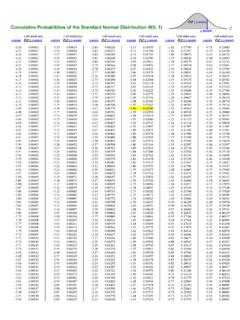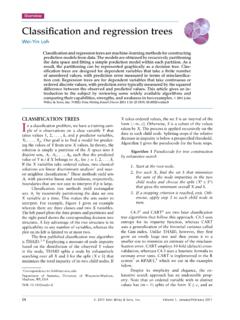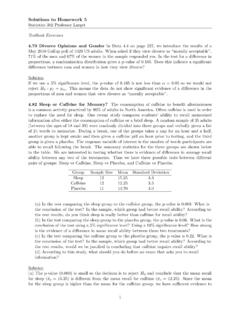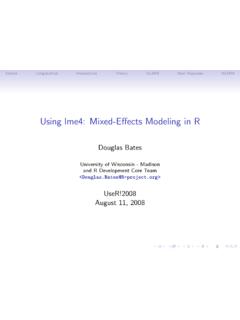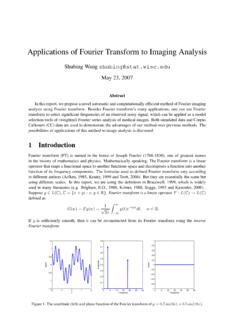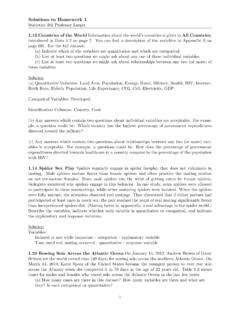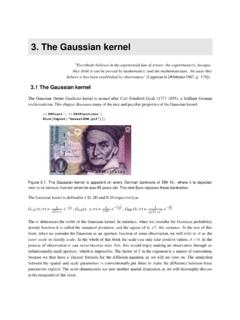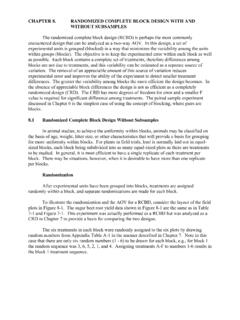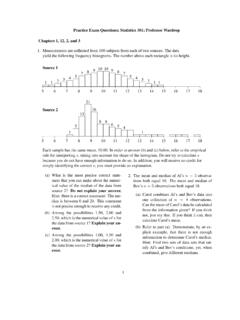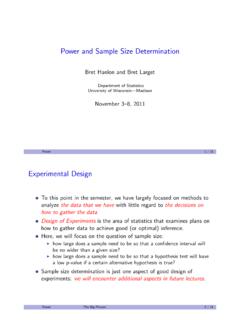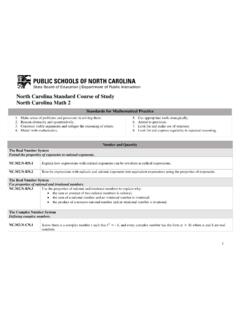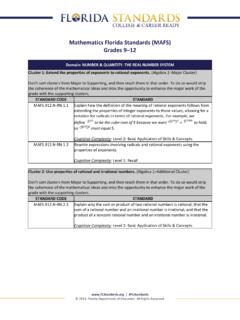Transcription of BASIC CALCULUS REFRESHER
1 1. BASIC CALCULUS REFRESHER . Ismor Fischer, Dept. of Statistics UW-Madison 1. Introduction. This is a very condensed and simplified version of BASIC CALCULUS , which is a prerequisite for many courses in Mathematics, Statistics, Engineering, Pharmacy, etc. It is not comprehensive, and absolutely not intended to be a substitute for a one-year freshman course in differential and integral CALCULUS . You are strongly encouraged to do the included Exercises to reinforce the ideas. Important mathematical terms are in boldface; key formulas and concepts are boxed and highlighted . To (). view a color .pdf version of this document (recommended), see ~ifischer. 2. Exponents BASIC Definitions and properties For any real number base x, we define powers of x: x0 = 1, x1 = x, x2 = x x, x3 = x x x, etc. (The exception is 00, which is considered indeterminate.) Powers are also called exponents. Examples: 50 = 1, ( )1 = , ( )2 = = , 103 = 10 10 10 = 1000, ( 3)4 = ( 3) ( 3) ( 3) ( 3) = 81.
2 Also, we can define fractional exponents in terms of roots, such as x1/2 = x , the square root of x. 3. Similarly, x1/3 = x , the cube root of x, x2/3 = ( x). 3 2. , etc. In general, we have xm/n =. n ( x) m , , th th the n root of x, raised to the m power. 3 2. Examples: 641/2 = 64 = 8, 643/2 = ( 64) 3. = 83 = 512, 641/3 = 64 = 4, 642/3 = ( 3. 64 ) = 42 = 16. 1 1 1 1 1. Finally, we can define negative exponents: x r = . Thus, x 1 = 1 , x 2 = 2 , x 1/2. = = , etc. xr x x x1/2 x 1 1 1 1 1 1 1 1. Examples: 10 1 = 2. 1 = , 7 = 2 = , 36 1/2. = = , 9 5/2. = = 5= . 10 7 49 36 6 5 3 243. ( 9). properties of Exponents 1. xa xb = xa+b Examples: x3 x2 = x5, x1/2 x1/3 = x5/6, x3 x 1/2. = x5/2. xa x5 2 x 3. x3. 2. = xa b Examples: 2. 3=x , 5=x , = x5/2. xb x x x1/2. 3. (xa)b = xab Examples: (x3)2 = x6, (x 1/2 7. ) = x 7/2. , (x2/3)5/7 = x10/21. 2. 3. Functions and Their Graphs Input x f Output y If a quantity y always depends on another quantity x in such a way that every value of x corresponds to one and only one value of y, then we say that y is a function of x, written y = f (x); x is said to be the independent variable, y is the dependent variable.
3 (Example: Distance traveled per hour (y). is a function of velocity (x). ) For a given function y = f(x), the set of all ordered pairs of (x, y)- values that algebraically satisfy its equation is called the graph of the function, and can be represented geometrically by a collection of points in the XY-plane. (Recall that the XY-plane Descartes ~ 1640. consists of two perpendicular copies of the real number line a horizontal X-axis, and a vertical Y-axis that intersect at a reference point (0, 0) called the origin, and which partition the plane into four disjoint regions called quadrants. Every point P in the plane can be represented by the ordered pair (x, y), where the first value is the x-coordinate indicating its horizontal position relative to the origin and the second value is the y-coordinate indicating its vertical position relative to the origin. Thus, the point P(4, 7) is 4 units to right of, and 7 units up from, the origin.). Examples: y = f (x) = 7; y = f (x) = 2x + 3; y = f (x) = x2; y = f (x) = x1/2; y = f (x) = x 1; y = f (x) = 2x.
4 The first three are examples of polynomial functions. (In particular, the first is constant, the second is linear, the third is quadratic.) The last is an exponential function; note that x is an exponent ! Let's consider these examples, one at a time. y = f (x) = 7: If x = any value, then y = 7. That is, no matter what value of x is chosen, the value of the height ( , 7) (0, 7) ( , 7). y remains at a constant level of 7. Therefore, all points that satisfy this equation must have the form (x, 7), and thus determine the graph of a horizontal line, 7 units up. A few typical points are plotted in the figure. Exercise: What would the graph of the equation y = 4. look like? x = 4 ? y = 0 ? x = 0 ? y = f (x) = 2x + 3: If x = 0, then y = f (0) = 2(0) + 3 = 3, so the point (0, 3) is on the graph of this function. Likewise, if x = , then y = f ( ) = 2( ) + 3 =. 0, so the point ( , 0) is also on the graph of this function. (However, many points, such as (1, 1), do not (0, 3).)
5 Satisfy the equation, and so do not lie on the graph.). The set of all points (x, y) that do satisfy this linear ( , 0). equation forms the graph of a line in the XY-plane, hence the name. Exercise: What would the graph of the line y = x look like? y = x ? The absolute value function y = |x| ? 3. Notice that the line has the generic equation y = f (x) = mx + b , where b is the Y-intercept (in this example, b = +3), and m is the slope of the line (in this example, m = +2). In general, the slope of any line is defined as the ratio of height change y to length change x, that is, y y2 y1. m = =. x x2 x1. for any two points (x1, y1) and (x2, y2) that lie on the line. For example, for the two points (0, 3) and y 0 3. ( , 0) on our line, the slope is m = = = 2, which confirms our observation. x 0. y = f (x) = x2: This is not the equation of a straight line (because of the squaring operation). The set of all points that satisfies this quadratic equation , ( 3, 9), ( 2, 4), ( 1, 1), (0, 0), (1, 1), (2, 4), (3, 9), etc.
6 Forms a curved parabola in the XY-plane. (In this case, the curve is said to be concave up, , it holds water. Similarly, the graph of x2 is concave down;. it spills water. ). Exercise: How does this graph differ from y = f(x) =. x3 ? x4 ? Find a pattern for y = xn, for n = 1, 2, 3, 4, . y = f (x) = x1/2 = x : The square root operation is not defined for negative values of x ( , 64 does not exist as a real number, since both (+8)2 = +64 and y = x2. ( 8)2 = +64.) Hence the real-valued domain of this function is restricted to x 0 ( , positive values and zero), where the square root operation is defined ( , +64 = +8). Pictured here is its graph, along y= x with the first-quadrant portion of y = x2 for comparison. Exercise: How does this graph differ from y = f(x) =. 3 3. x1/3 = x ? Hint: What is its domain? ( , +64 = ??, 3. 64 = ???) Graph this function together with y = x3. The square operation x2 and square root operation x1/2 = x are examples of inverse functions of one another, for x 0.
7 That is, the effect of applying of either one, followed immediately by the other, lands you back to where you started from. More precisely, starting with a domain value x, the composition of the function f(x) with its inverse written f 1(x) is equal to the initial value x itself. As in the figure above, when graphed together, the two functions exhibit symmetry across the diagonal line y = x (not explicitly drawn). 4. 1. y = f (x) = x 1 = : This is a bit more delicate. Let's first restrict our attention to positive x 1. domain x-values, , x > 0. If x = 1, then y = f (1) = = 1, so the point (1, 1) lies on the graph of 1. this function. Now from here, as x grows larger ( , x = 10, 100, 1000, etc.), the values of the 1 1 1 1. height y = = = = etc. become smaller, although they x 10 100 1000. never actually reach 0. Therefore, as we continue to move to the right, the graph approaches the X-axis as a horizontal asymptote, without ever actually touching it. Moreover, as x gets smaller from the point (1, 1) on the graph ( , x = , , , etc.)
8 , the values of the height 1 1 1 1. y = = 10 = 100 = 1000 etc. become larger. Therefore, as we x continue to move to the left, the graph shoots upwards, approaching the Y-axis as a vertical asymptote, without ever actually touching it. (If x = 0, then y becomes infinite (+ ), which is undefined as a real number, so x = 0 is not in the domain of this function.) A similar situation exists for negative domain x-values, , x < 0. This is the graph of a hyperbola, which has two symmetric branches, one in the first quadrant and the other in the third. (1, 1). 1. Exercise: How does this graph differ from that of y = f (x) = x 2 = ? Why? x2. 5. NOTE: The preceding examples are special cases of power functions, which have the general form y = x p, for any real value of p, for x > 0. If p > 0, then the graph starts at the origin and continues to rise to infinity. (In particular, if p > 1, then the graph is concave up, such as the parabola y = x2. If p = 1, the graph is the straight line y = x.)
9 And if 0 < p < 1, then the graph is concave down, such as 1 1. the parabola y = x1/2 = x .) However, if p < 0, such as y = x 1 = , or y = x 2 = 2 , then the Y-axis x x acts as a vertical asymptote for the graph, and the X-axis is a horizontal asymptote. y = xp p>1. p=1. 0<p<1. p=0. p<0. Exercise: Why is y = xx not a power function? Sketch its graph for x > 0. Exercise: Sketch the graph of the piecewise-defined functions x2, if x 1 This graph is the parabola y = x2 up to and including the f (x) = point (1, 1), then picks up with the curve y = x3 after that. Note that this function is therefore continuous at x3 , if x > 1 x = 1, and hence for all real values of x. x2, if x 1 This graph is the parabola y = x2 up to and including the g (x) = point (1, 1), but then abruptly changes over to the curve y = x3 + 5 after that, starting at (1, 6). Therefore, x3 + 5, if x > 1. this graph has a break, or jump discontinuity, at x = 1. (Think of switching a light from off = 0 to on = 1.
10 However, since it is continuous before and after that value, g is described as being piecewise continuous. 6. y = f (x) = 2x: This is not a power function! The graph of this increasing function is an exponential growth curve, which doubles in height y with every unit increase ( , + 1) in x. (Think of a population of bacteria that doubles its size ever hour.) If the exponent is changed from x to x, then the resulting graph represents an exponential decay curve, decreasing by a constant factor of one-half from left to right. (Think of half-life of a radioactive isotope, , carbon dating of prehistoric artifacts, fossils, etc.). NOTE: For general exponential functions y = f(x) = bx, the base b can be any positive constant. The resulting graph increases if b > 1 ( , b = 2 in the previous example), and decreases if b < 1. ( , b = 1/2). Exercise: How do the graphs of the functions (1/2)x and 2 x compare, and why? One very important special choice for CALCULUS applications is called e = , labeled for Swiss mathematician Leonhard Euler (pronounced oiler ), 1707-1783.
